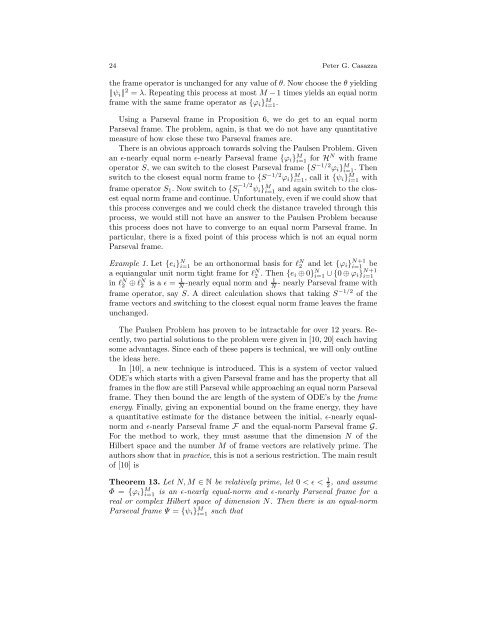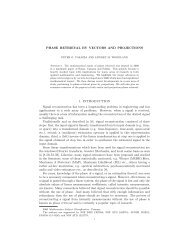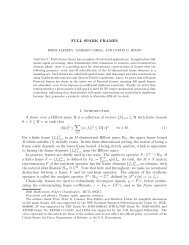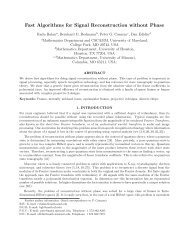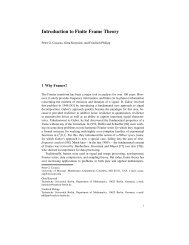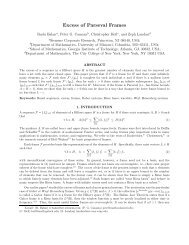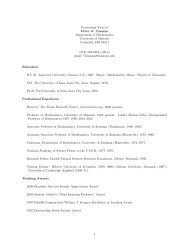The Kadison-Singer and Paulsen Problems in Finite Frame Theory
The Kadison-Singer and Paulsen Problems in Finite Frame Theory
The Kadison-Singer and Paulsen Problems in Finite Frame Theory
Create successful ePaper yourself
Turn your PDF publications into a flip-book with our unique Google optimized e-Paper software.
24 Peter G. Casazzathe frame operator is unchanged for any value of θ. Now choose the θ yield<strong>in</strong>g‖ψ i ‖ 2 = λ. Repeat<strong>in</strong>g this process at most M − 1 times yields an equal normframe with the same frame operator as {ϕ i } M i=1 .Us<strong>in</strong>g a Parseval frame <strong>in</strong> Proposition 6, we do get to an equal normParseval frame. <strong>The</strong> problem, aga<strong>in</strong>, is that we do not have any quantitativemeasure of how close these two Parseval frames are.<strong>The</strong>re is an obvious approach towards solv<strong>in</strong>g the <strong>Paulsen</strong> Problem. Givenan ɛ-nearly equal norm ɛ-nearly Parseval frame {ϕ i } M i=1 for HN with frameoperator S, we can switch to the closest Parseval frame {S −1/2 ϕ i } M i=1 . <strong>The</strong>nswitch to the closest equal norm frame to {S −1/2 ϕ i } M i=1 , call it {ψ i} M i=1 withframe operator S 1 . Now switch to {S −1/21 ψ i } M i=1 <strong>and</strong> aga<strong>in</strong> switch to the closestequal norm frame <strong>and</strong> cont<strong>in</strong>ue. Unfortunately, even if we could show thatthis process converges <strong>and</strong> we could check the distance traveled through thisprocess, we would still not have an answer to the <strong>Paulsen</strong> Problem becausethis process does not have to converge to an equal norm Parseval frame. Inparticular, there is a fixed po<strong>in</strong>t of this process which is not an equal normParseval frame.Example 1. Let {e i } N i=1 be an orthonormal basis for lN 2 <strong>and</strong> let {ϕ i } N+1i=1 bea equiangular unit norm tight frame for l N 2 . <strong>The</strong>n {e i ⊕ 0} N i=1 ∪ {0 ⊕ ϕ i} N+1i=1<strong>in</strong> l N 2 ⊕ l N 2 is a ɛ = 1 N -nearly equal norm <strong>and</strong> 1 N- nearly Parseval frame withframe operator, say S. A direct calculation shows that tak<strong>in</strong>g S −1/2 of theframe vectors <strong>and</strong> switch<strong>in</strong>g to the closest equal norm frame leaves the frameunchanged.<strong>The</strong> <strong>Paulsen</strong> Problem has proven to be <strong>in</strong>tractable for over 12 years. Recently,two partial solutions to the problem were given <strong>in</strong> [10, 20] each hav<strong>in</strong>gsome advantages. S<strong>in</strong>ce each of these papers is technical, we will only outl<strong>in</strong>ethe ideas here.In [10], a new technique is <strong>in</strong>troduced. This is a system of vector valuedODE’s which starts with a given Parseval frame <strong>and</strong> has the property that allframes <strong>in</strong> the flow are still Parseval while approach<strong>in</strong>g an equal norm Parsevalframe. <strong>The</strong>y then bound the arc length of the system of ODE’s by the frameenergy. F<strong>in</strong>ally, giv<strong>in</strong>g an exponential bound on the frame energy, they havea quantitative estimate for the distance between the <strong>in</strong>itial, ɛ-nearly equalnorm<strong>and</strong> ɛ-nearly Parseval frame F <strong>and</strong> the equal-norm Parseval frame G.For the method to work, they must assume that the dimension N of theHilbert space <strong>and</strong> the number M of frame vectors are relatively prime. <strong>The</strong>authors show that <strong>in</strong> practice, this is not a serious restriction. <strong>The</strong> ma<strong>in</strong> resultof [10] is<strong>The</strong>orem 13. Let N, M ∈ N be relatively prime, let 0 < ɛ < 1 2, <strong>and</strong> assumeΦ = {ϕ i } M i=1 is an ɛ-nearly equal-norm <strong>and</strong> ɛ-nearly Parseval frame for areal or complex Hilbert space of dimension N. <strong>The</strong>n there is an equal-normParseval frame Ψ = {ψ i } M i=1 such that


